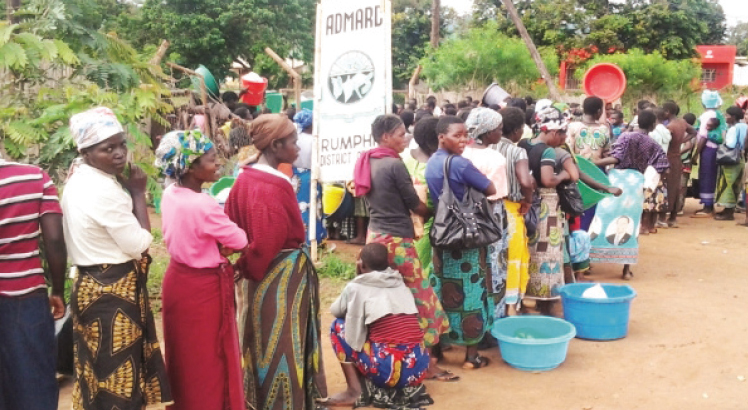How the Admarc empire was lost
From the vibrant 1970s and 1980 to the apparent lethargy of today, the journey of Admarc is a story of an empire going to sleep. What has been behind this? Weekend Nation tackles this in this second part of Admarc series.
Admarc is losing it; in fact, even scholars agree it not as effective as it used to be.

Ephraim Chirwa, professor of economics at Chancellor College, notes that between the 1970s and 1980s, Admarc had good and consistent performance.
He argues that not only did it provide vital services to smallholder farmers including assured and reliable markets for smallholder output, most importantly, it also made payment of farmers with cash on delivery and again provided credit and subsidised inputs.
“It also helped in the stabilisation of prices seasonally and annually, payment of higher maize prices to producers than the export parity prices and in the provision of subsidised maize and rice to consumers,” he says.
However, notes the professor, Admarc started experiencing problems in the early 1980s.
He says deterioration of terms of trade adversely affected Admarc’s profitability together with illiquidity of its investments portfolio.
Not only that.
Chirwa also points that change in government pricing policies coupled with adverse weather conditions were another stern challenge.
As if that was not enough, a government directive to establish and manage a strategic grain reserve against a background of increasing external transport and finance hit Admarc hard, says the professor.
But it was the market liberalisation movements in the late 1980s and 1990s that came to be the last nail in Admarc’s coffin.
Chirwa notes that the liberalisation of agricultural output markets in 1987, which mostly came in form of licensing of private traders, threw Admarc into a corner.
By 1996, he adds, licensing was no longer a requirement for the marketing of smallholder agricultural crops.
“As a result, the role of Admarc in maize purchases from smallholder farmers substantially declined after 1994. Private sector competed out Admarc on prices,” he says.
He further notes that liberalisation of agricultural input markets in 1991 also dented Admarc’s other marketing activity.
The visible decline of Admarc’s influence became a thorn on the conscience of government. Government, then, had to reason outside the box to revamp the institution into its glorious days. However, with the governance system having changed from dictatorship to democracy, getting Admarc on its toes, like it used to, proved a critical and sensitive issue.
Some reforms, as a result, were proposed. Others proposed the need to sell Admarc’s 204 loss-making markets (out of 350). Others proposed the splitting of Admarc into commercial and social functions. While some proposed leasing its unit markets to the private sector.
However, amidst proposed reforms consequent financial difficulties made Admarc the target of donor-driven Structural Adjustment Policies (SAPs) that eventually transformed it into a limited company through the 2003 Admarc Act.
What resulted were the establishment of Admarc Limited and an incorporation of Admarc as a limited company in 2004 with 99 percent government ownership.
Questions were raised: Is this commercialisation of Admarc? Or has Admarc changed its mandate?
According to Admarc Limited, its roles included procuring and selling farm inputs such as fertilisers, seeds and pesticides for crops to all smallholder farmers in Malawi.
Not only that.
Other roles involved buying produce from both traders and smallholder farmers at good prices, add value for sale on both export and local markets; ensuring easy accessibility of staple food maize in the country through a vast market network; provision of reliable markets for smallholder produce and, again, attending to social obligations on behalf of government through handling and selling of Farm Inputs Subsidy Programme (Fisp).
So, has the incorporation of Admarc a limited company made any difference?
Chirwa does not see the difference. He argues that incorporation made it difficult for Admarc to obtain subvention from Treasury. He noted that the institution continues to experience financial difficulties—high liquidity problems.
What Chirwa advances concurs with a study Oxfam recently released about Admarc. The study shows that the growth of the agriculture sector over the years has resulted into increased volumes of marketed quantities being available on the local markets which Admarc is failing to effectively buy from farmers.
“For the major crops such as maize, groundnuts, soya beans, rice and pigeon peas, it is estimated that about 20 to 50 percent of the national budget would have been required to purchase such crop produce from the smallholder farmers across the country.
“This, therefore, justifies the market liberalisation policy, but more importantly, it justifies the need for increased Admarc financial muscle to be an effective player in the agricultural produce market,” reads the study.
However, although budgetary allocations to the agriculture sector from 2004/2005 to 2014/2015 financial years show a healthy national resource allocation, the study noted that the larger part has gone to Fisp.
The plausible expenditure growth trends in the agriculture sector as a whole, the study reveals, have not translated into growth trends in budgetary allocations to Admarc.
For instance, the study shows that between 2004/05, and 2014/15, Admarc funding share to the agriculture sector budget has been hovering around an average of 2 percent of the agriculture sector budget, with minimum being 0.3 percent in 2008/09 and the highest being 6 percent recorded for 2004/05 when the country had a food security crisis.
“This reduced funding to Admarc could best be explained as one of the other effects, among others, of the restructuring programme under which the Malawi Government committed itself which entailed stopping sub-venting some parastatal organisations, including Admarc.
“In line with the reform policy direction on Admarc, we observe that there are certain years when there are no direct funding provisions to Admarc such that the 2007/08 and 2012/13 financial years there were no funds approved for Admarc,” reads the study.
On whether incorporation of Admarc made a difference, public policy specialist, Blessings Chinsinga, an associate professor at Chancellor College, notes that the gist of the transformation into a limited company was to separate Admarc’s social and commercial functions but this has not really taken off because government has resisted wholesale privatisation of Admarc.
“Even the Kamuzu Banda government reneged on the implementation of SAPs due to a hunger crisis in 1992; the same was repeated by the Muluzi as well as the Bingu wa Mutharika governments, reintroducing subsidies prompted by pervasive hunger crises,” he says.
He adds that the Bingu wa Mutharika government even went to the extent of banning private maize trading in 2008, designating Admarc as the exclusive legal buyer of maize.
However, he continues, even with this ban, Admarc was never properly capitalized to fulfill this particular mandate—with scholars and research showing that from 2006 to-date, Admarc’s great difficulty is inadequate funds.
Chinsinga notes that the main challenge is that the ruling elites are torn between two worlds.
“They want to access donor money associated with reforms (for example, the passing of the 2003 Admarc Act) but at the same time they want to be seen by the electorate to be doing something about the historical sanctity of Admarc,” he says.
The consequence, notes Chinsinga, is that Admarc, today, is stuck in no man’s land due to strong ideological motivations.
“Donors believe in efficiency and economic growth to be released by the forces of the market while ruling elites hold on to the idea of a traditional Admarc largely for selfish interests,” he says.
Chirwa, too, notes that one key challenge with Admarc Limited is that it remains highly politicised—what with its top boss being appointed by the President and not through a competitive recruitment processes.
However, results of a study commissioned by both donors in collaboration with government and independently by civil society organisations show that there is a strong case for creative action in order to get Admarc moving again.
So which way should Admarc go?





